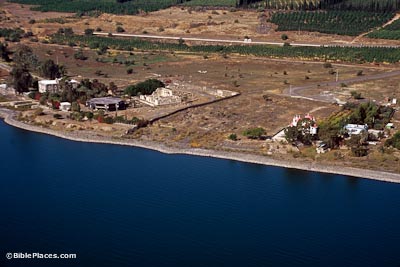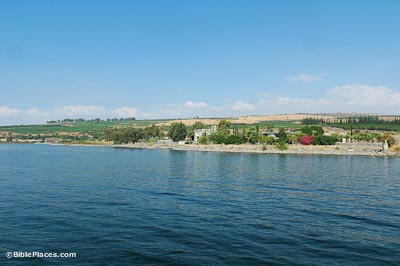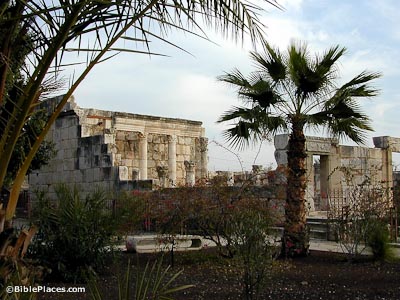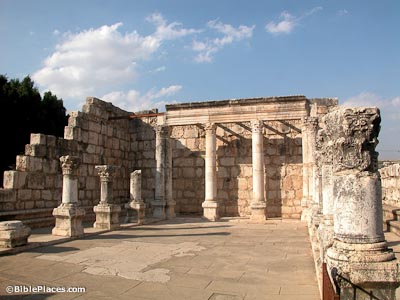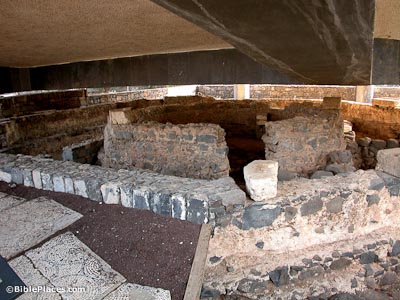Capernaum
Also known as Tell Hum, Khirbet Karazeh, Bethsaida, Capharnaum, Chorazin, Kefar Nahum, Kafarnaum, Kefar Tanhum, Talhum, Tanhum
Aerial View
Populated from the 2nd century BC to the 7th century AD, Capernaum was built along the edge of the Sea of Galilee and had up to 1,500 residents.
Today the ruins are owned by two churches: the Franciscans control the western portion with the synagogue and the Greek Orthodox property is marked by the white church with red domes.
View from the Sea
Jesus made Capernaum his home during the years of his ministry: “Leaving Nazareth He went and lived in Capernaum” (Matt 4:13).
Peter, Andrew, James, and John were fishermen living in the village. Matthew the tax collector also dwelt here.
Capernaum is one of the three cities cursed by Jesus for its lack of faith.
The Synagogue
The date of this synagogue is debated, but it is clearly later than the first century. Excavations have revealed a synagogue from the time of Jesus with walls made of worked stone, 4 feet (1.2 m) thick.
These earlier walls were preserved up to 3 feet (0.9 m) high. The entire western wall still exists and was used as the foundation for the later synagogue.
The Synagogue
Jesus was confronted by a demoniac while teaching here (Mark 1:21-27).
In Capernaum, Jesus healed the servant of the centurion. This Roman official was credited with building the synagogue (Luke 7:3).
In this synagogue, Jesus gave a sermon on the bread of life (John 6:35-59).
The House of Peter
Excavations revealed one residence that stood out from the others. This house was the object of early Christian attention with 2nd-century graffiti and a 4th-century house church built above it. In the 5th century, a large octagonal Byzantine church was erected above this, complete with a baptistery. Pilgrims referred to this as the house of the apostle Peter.
Download all of our Galilee and the North photos!
$39.00 $49.99 FREE SHIPPING
Related Websites
See historical photos of Capernaum at Life in the Holy Land.
For Bible chapters related to Capernaum, see Matthew 17, Mark 1, Luke 4, and Luke 7. See also the related sites of Sea of Galilee, Bethsaida, Chorazin, Cove of the Sower, Mt. of Beatitudes, and Tabgha.
Capernaum, the City of Jesus (PDF article by David Padfield) This outlined article includes pictures and extensive information about the site, ancient and modern.
Capernaum—From the Air (Ferrell Jenkins) Two excellent aerial images of Capernaum.
Capernaum (Tourist Israel) A helpful introduction to the site and how to visit.
Village of Comfort – Capernaum (Sar-El) This brief article is accompanied by a 3-minute video that offers a good visual introduction to the site.
Capernaum (Crystalinks) Includes a map showing Capernaum’s location and information on each primary archaeological area within the site, along with photos.
The Synagogue at Capernaum (Jewish Virtual Library) Gives an interesting and detailed history of the synagogue, including links to descriptions of related terms.
Three Things in Capernaum that Peter Likely Saw (Bible Archaeology Report) This easy-to-read article features pictures, a reconstruction drawing of the shoreline, and a reference list with some online resources in addition to print ones.
Capernaum (Into His Own) A brief, encyclopedia-type article with multiple links to related words and topics for further study.
Ancient synagogues in Bar’am and Capernaum (The Jewish Magazine) Offers an interesting look at early synagogues in general; looks specifically at two Galilean synagogues.
Capernaum: A Town That Lost Its Light (Israel My Glory) This article from Elwood McQuaid gives a good look at Capernaum as a place in Scripture.
The House of Peter: The Home of Jesus in Capernaum? (Biblical Archaeology Society) Includes a photo of the House of Peter from before the more modern construction over it; along with great information about what was excavated there.
Simon Peter in Capernaum: An Archaeological Survey of the First-Century Village (Brigham Young University) This extensive article (with footnotes) includes a few photos, and gives a deep-dive into the cultural and physical surroundings of Peter.
